Route: Ciudad Rodrigo – La Alberca – Hervas – Avila – Segovia – Olmedo – Valladolid

Just beyond the Portugese / Spanish border lies the tiny historical town of Ciudad Rodrigo. I had noticed it on my maps all those years, but it is in such an out of the way corner of Spain that I thought I’d probably never reach it. But here I am.
Nice little place. Old town up the hill. Impressive old city walls, a castle tower, an old cathedral, the house of the marquis which I liked a lot, …. yeah, it’s worth a visit.


I check into a hotel for two nights. Lot’s of stuff to do, besides typing for this website. Laundry, bike cleaning, visit restaurants, downloading podcasts, recharging all the devices, etc, etc…
On my rest day in Ciudad Rodrigo I strolled back towards the old town to have another look at all the old buildings and have lunch. After lunch, I walked the loop over the old town walls. didn’t see another person. It’s siesta time, you’re not supposed to walk, I guess haha.

My legs needed a bit of a rest period as well, I was thinking. They felt rather tired after the constant climbing, day after day since I reached the Pyrenees. “Nothing better than some riding along canals to give the legs some rest”, I thought. We’re in mountainous Spain, and not in flat Belgium, but there happen to be canals a few hundred kilometer north from here, the ‘Canal de Castilla’. I started investigating whether I could include that into my ride somehow.
From one thing came another. The idea is to go eventually further south, to Extremadura, but the canals are north from here so I have to make a loop somehow in order to avoid riding the exact same thing twice.
I could ride via Avila, that’s supposed to be an interesting town. And then, I’m not far from Segovia, with it’s picturesque cathedral and….’.
Oh, and there’s another greenway I could include, and then go to the canals this way, return that way, a bit of Via de la Plata there, and ….
It’s proven again that too much thinking is good for nothing. In search of a way to give the legs some rest, I just added another thousand kilometer with a hilly passage through the Sierra the Francia and the Sierra de Bejar and yes, also some riding along the Castilla Canals.
It’s going to be fun ! 🙂 🙂
The ride from Ciudad Rodrigo to La Alberca over the main road is easy. La Alberca is at 1.050 m asl or so. Super touristic, even on a weekday. This typical old houses with wooden frames. A bit like in Troyes and Bergerac in France. Lots of shops selling the Jamón (ham) for which the region is famous, lots of typical tacky tourist shops with t-shirts, bags, magnets to put on your fridge, restaurants with menu del dia’s, pinchos (tapas), ….



This stuff is not for me anymore. I leave town after 45 minutes and find myself an ok place under the chestnut trees to camp. The night definitely is going to be quieter than last night in the hotel with it’s banging doors well into the night (despite the noise isolation which the hotel advertised but was totally non-existing).


I had put a lot of time in preparing my little loop in Castilla y Leon, starting from Hervas, but not too much time in the route from Ciudad Rodrigo to Hervas. That night, I suddenly remembered that, months ago, I already looked into some nice roads in this area. Instead of riding straight to Hervas the next morning, I rode back up to La Alberca and from here took the road straight south into the Parque Natural Batuecas. From La Alberca, I first have to climb a little bit higher to the Puerto del Portillo Pass (1.247 m). From the pass, I have a brilliant view to all the lower hills in Extremadura region. On the downhill, a series of switchbacks until I reach the Rio Batuecas. I take a little side road to visit the Monasterio de las Batuecas, but it’s not open for visitors.





Never mind. I keep going down. Although I’m supposed to be on a tour of Castila y Leon region, I am entering Extremadura region for a while. I ride already a part of the northern section of the Cicloextremeña, a loop that follows the borders of Extremadura region. More about that in a few weeks, when I’ll ride the rest of it.
It’s one of the harder stretches of that loop that I’m doing now.
After Riomalo de Abajo, situated at the confluence of the Rio Ladrillar and the Rio Alagon, I climb steep on a stony dirt track. This is the start of a remote section, closed to motorized traffic and without any services for 60 kilometer.
Heaven.




Down below, I can see the wide body of water, the Rio Alagon. Also the Rio Hurdano joins and eventually, as always when there’s some water here, they’ve built a dam and created the large Embalse de Gabriel Y Galan. It’s a fantastic off-road ride through the forest. I take a right turn on the dead end road towards Granadilla, which is supposed to be an interesting place down at the lake. From far away I can see the fortress already. I arrive at 2.15 pm. The whole village is closed with the big iron gate from the middle ages. Entry to town is only in the morning and late afternoon / early evening. Basically the times shops are open in other places. Nothing to do but to ride back where I came from. It is paved roads from now towards Abadia, then Aldeanueva Del Camino, a place I passed through in 2017 as well when cycling the Via de la Plata.





What’s changed now is there is a via verde from here, going to Hervas, a historical town further up the hill and all the way to Bejar, the town at the pass. In 2017 I still had to go through the busy valley. A good improvement !
Hervas is a nice place. A real town this time, not like the tourist Disneyland of La Alberca. I was hoping to pick-up a package send from home 10 days ago with a new solar panel, a new rear tyre and my old gps, as the current one is failing, but the package is still in Brussels. It seems that in this period of time, the Belgian Post can bring a package only from the north of the country to the centre of the country, a whopping distance of about 60 km in 10 days. I walk faster.

Well, we’ll see. Maybe they get it on a plane one day and hopefully it arrives when I return here at the end of my Castilla y Leon loop.
I visit the town church (from the outside, because it is closed) and the old Jewish quarter.







All the time since leaving the closed town of Granadilla, I was riding east and looking to a wall of mountains, the Sierra de Bejar. When I passed here in April 2017, I was riding south to north alongside them, and the tops were still covered in snow.. Not so now of course. But this time, I had to get over the range.
It’s a very easy climb. The hardest thing were the persistent hundreds of little flies going around my head all the time, trying to enter my mouth, ears, eyes,…. I haven’t mentioned it yet, I think, but it is terrible this year. I’ve never had that amount of flies and mosquitos in Spain as this year. Climate change ?
Anyway, there are many, many, many more of this irritating bugs than normally and they make my life out in nature hard. Riding the bike they swarm around you when you’re climbing, slow and sweating. At night, they eat you at your camp site.

Once over the top (unnamed pass, 1.313 m), I am back in Castilla y Leon. On my left hand is yet another Embalse (Embalse de Navamuno).
Candelario, the first town is really beautiful again and worth a visit.



In Puente Del Congosto I went back on dirt, following the ‘Cañada Real Soriana’. Fantastic riding again. The mountains of the Sierra de Gredos to my right, the high plains to my left. Some stretches are pretty desolate, but that’s what I like.

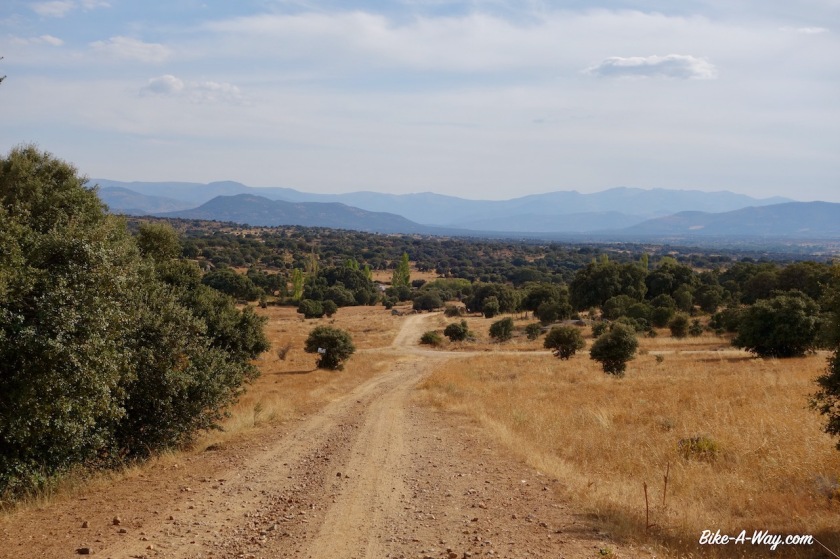








I toured around Avila a bit. The cathedral was closed right in front of my nose for siesta. No problem. Enough buildings to look at from the outside. Avila is most famous for its old city walls. Apparently you can walk them, but I never found a place where I could mount them. Avila is the birth place of the cyclist Julio Jimenez who won three times polka dot jersey in the Tour the France and was also three times King of the Mountains in the Vuelta.




East from Avila there’s a bike path of about 14 km. First night camping along it, a terrible thunderstorm passed by. Thousands and thousands of lightnings right above the tent. Of course, I am at the highest point 20 or 30 kilometer around. Also a lot of rain came down, but that’s good because the region is really dry and fires are still a concern when camping.
The bike path stops at the village of Urraca-Miguel and I have to take the paved road Av-500 further east. As the road is blocked for road works, and the busy N-110 is not an option, I pushed the bike up a steep path, 14 upto 16% inclination. It had a dead-end at the top. By the time I was down again, it was siesta time and I saw the road workers leaving. Time to hit right through the road works.

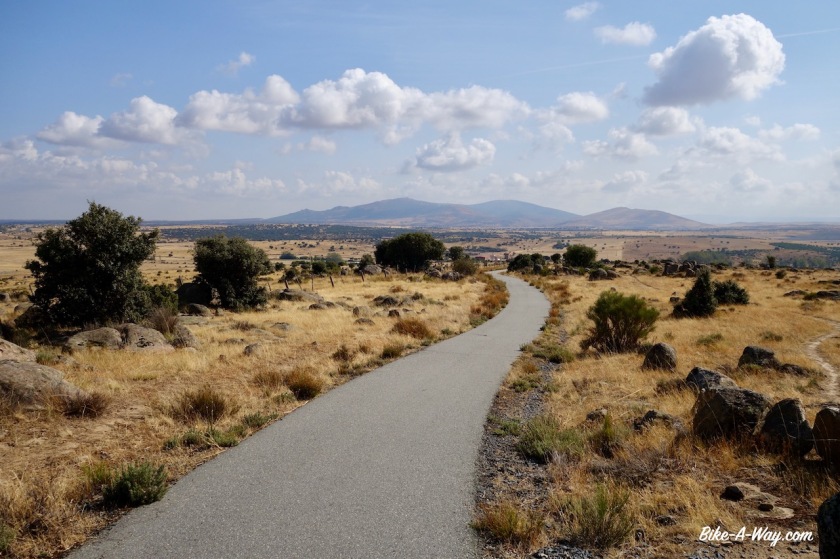




Arriving in the town of El Espinar, all shops are closed. It’s fiesta. Some obscure saint. Nobody knew exactly why.
Up to Segovia. Against the wind ever since entering Spain. Luckily I have the Sierra de Guadarrama on my right to admire. After Segovia, I make an 180 degrees turn and ride back west. I bet the wind, after blowing all these days will do exactly the same.
But first a visit to the city. The two main highlights are the enormous Roman Aqueduct and the cathedral. The entrance fee to the cathedral was 3 euro, I think, but it is worth it. In the basement is a museum with paintings in the style of the old Flemish masters like Rubens and Van Eyck, a sign says.
While the paintings were reproductions by Spanish painters, another museum with carpets showed carpets all from Brussels. Probably taken when the Spanish ruled in our region.
Segovia is also the birth place of cyclist Pedro Delgado.








Segovia was the place where I turned west again, but more important, it is the place where some easier part follows. I have the Via Verde Del Eresma ahead of me. 73 km of almost flat gravel riding. I loved the stretch, cycling along the Eresma river, through the pine forests, all traffic free, enjoying the scenery while listening to some podcasts. And I was completely wrong about that wind. It just kept blowing from the east and made my life very easy for once 🙂


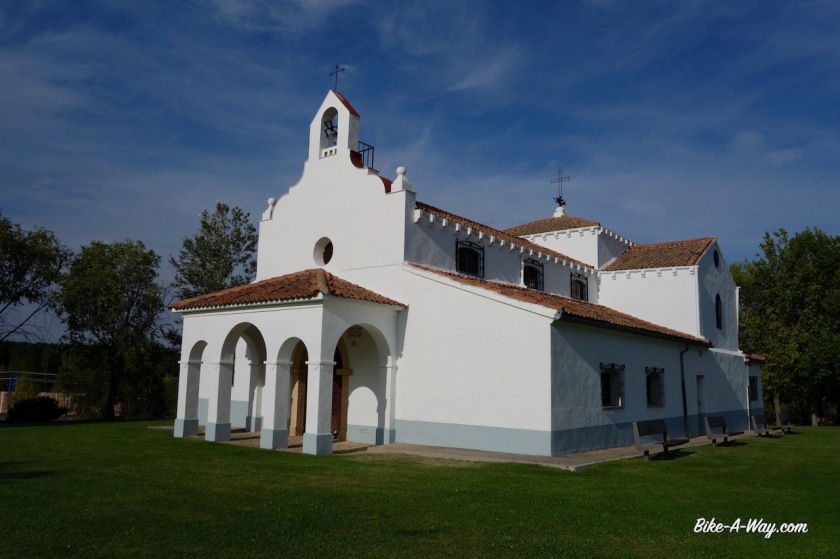







Olmedo is the terminus of the via verde. I follow a few kilometer of bitumen before going on sandy roads again, over yet another camino to Santiago, this time the one from Madrid, the Ruta Jacobea Madrilena. Valladolid is the capital of the autonomous region Castila y Leon. Quite a big town with over 300.000 people. Before entering the town, I again cross the Douro River, which I crossed a few weeks ago further downstream in Portugal already. The Douro river is Spains third longest river (895 km).
I didn’t ride into the centre of town, as I was chased by rain and thunderstoms. The city lies at the Pisuerga River. I also crossed this river a few weeks ago when cycling in the Cordillera Cantabrica, in the town of Cervera de Pisuergo.



Here in Valladolid I will start my flat ride along the Castilla Canal, but that’s for the next post.


















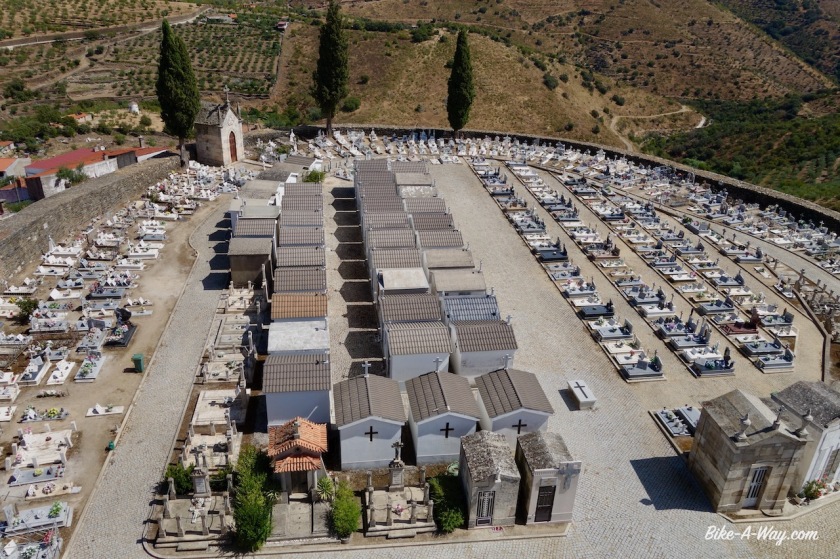

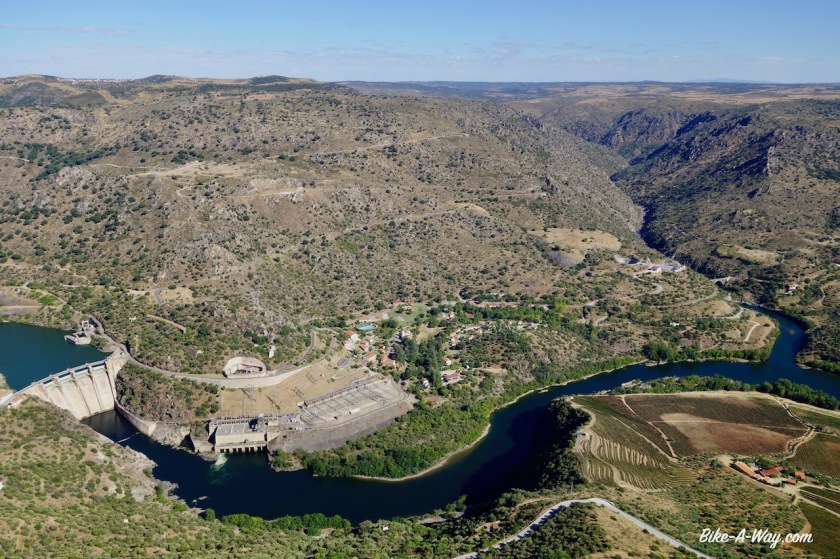








 In the little town Urros there was no shop to be found and no water fountain so I asked an old lady to refill my water bottles.
In the little town Urros there was no shop to be found and no water fountain so I asked an old lady to refill my water bottles.












 In Castelo Rodrigo, I ask the lady of the tourist info after which Rodrigo the place is named, and whether it is the same Rodrigo as in Ciudad Rodrigo, the bigger town a bit further in Spain.
In Castelo Rodrigo, I ask the lady of the tourist info after which Rodrigo the place is named, and whether it is the same Rodrigo as in Ciudad Rodrigo, the bigger town a bit further in Spain.









































